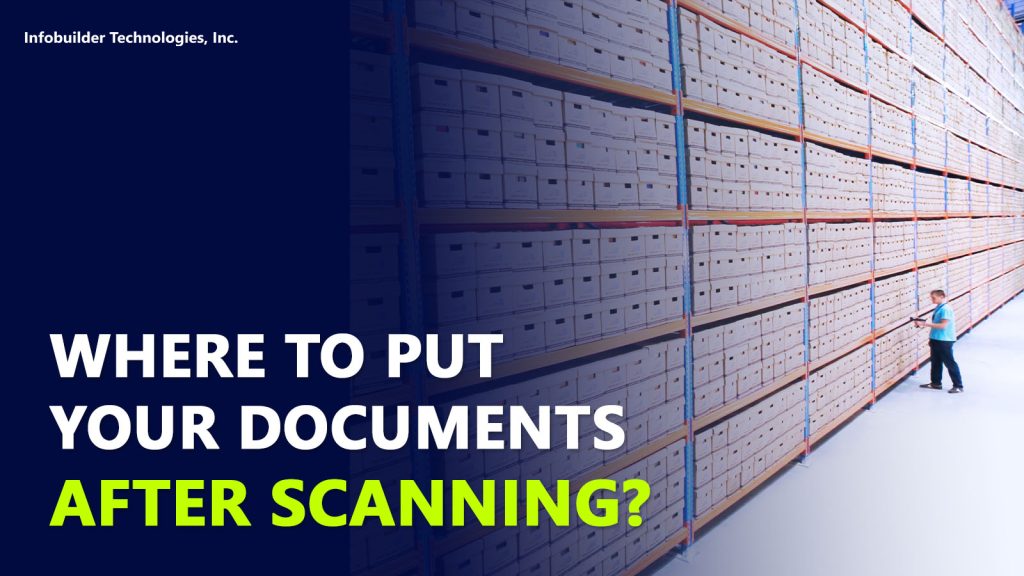Inspirations

Where to Put Your Documents After Scanning?
Posted on July 1, 2022
The records management process doesn’t end with sending your documents off for scanning. After making your records digitally available, a new question arises: Where should you put those piles of physical records thereafter? Below is a brief guide to help you decide.
WHAT ARE YOUR OPTIONS?
To date, businesses and organizations can store their physical records in two ways: onsite or offsite. Find out which storage solution is the better fit for your needs.
Onsite Document Storage
As the name suggests, this type of storage solution involves the storing and managing of documents within the actual workplace or site of business. The use of filing cabinets and lockers within the operations premises is a common example of how onsite document storage works.
Under this setup, you are to create and manage your own storage space, and it is up to you how you will fashion and handle your storage units.
You may choose to invest in office-based document storage solutions. But before you do, it’s important to take into consideration the following:
PROS
- Hardcopies of your records are within your reach
Keeping your physical records onsite translates to easy access to frequently used documents. This is especially important to companies engaged in law, insurance, and real estate. Employees can simply dig through the drawers or scan the cabinets to retrieve physical copies of forms and reports should they need them.
CONS
- Takes up valuable office space
Records pile up fast as your business grows. Eventually, the stash of papers and CDs can take up a lot of physical space on your business premises. This results in more distractions to your employees, limited movements within the office, and essentially, lower productivity.
- Requires time and effort
Onsite document storage is essentially a DIY activity. From sorting, labeling, to tracking, you are expected to handle all aspects of your organization’s records management. Without investing time and effort, records may get shuffled, lost, or misplaced, and finding the needed documents may take more time than necessary.
- Less secured
Keeping your physical records onsite makes them susceptible to theft and damages. From fire, flood, to pests, many elements can destroy your files within the office. Leaving them there also makes them easily accessible to anyone, resulting in a possible security breach and data leakage.
Offsite Document Storage
Another way to store your physical documents is by sending them to a third-party storage company. Here, material files are transported to a different facility managed by a records management service provider.
The process is pretty much simple. You may contact a known document management facility in your area, talk with them about your needs and goals, and schedule a pickup for your hardcopy documents for immediate storing.
Similar to onsite storage, offsite document management has its own pros and cons. Among these include:
PROS
- Saves up office space
Storing your material records offsite is a good way to maximize office space. This leaves your employees with bigger rooms for work, fewer distractions, and an overall improved working environment.
- Experts will get things done for you
Third-party records management companies take pride in their well-trained specialists. Leaving your files in their hands relieves you from the burden of having to sort and track your documents on your own. Most facilities also use advanced barcode systems to enable easy access and retrieval of items whenever needed.
- Improved security
Companies offering offsite storage solutions are expected to be highly secured. Most come with 24/7 CCTV surveillance, burglar alarms, fire protection, and other security solutions.
CONS
- Physical records are not readily available in the office
One of the obvious downsides of storing your documents offsite is that physical records are away from you. This may cause a delay in business activities when hardcopy documents are urgently needed. Fortunately, some records management providers are equipped with advanced order platforms for easy retrieval of documents.
- Requires preparation
There are a few things you need to do before sending your physical documents for offsite storage. Among these activities include choosing what files to send, labeling and indexing files for easy identification, and more. Infobuilder strives to lift this burden off your shoulders by making sure your electronic documents are tied up with their physical location. This makes it easier for your organization to know what items to pull out in case you need them in the future.
KICKSTART YOUR DIGITIZATION JOURNEY WITH US!
Planning to go paperless soon? As one of the Top 25 Document Management System (DMS) providers in the Asia Pacific, we guide our clients into the entire digitization process.
You may talk to us to know more about our scanning services, possible storage solutions, retention policy services, and enterprise content management services.

